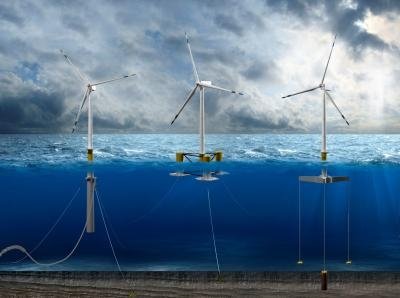Sign up for daily news updates from CleanTechnica on email. Or follow us on Google News!
There’s a lot of talk these days about how much electricity it takes to operate data centers. Those concerns are fully justified, as those data centers consume as much as 1.5% of all the electricity generated in the world today. That number could increase dramatically if the use of artificial intelligence expands as expected. There is a secondary concern associated with data centers, namely what to do with the heat created by all those chips, microprocessors, and servers? Google announced this week that it will send the waste heat from its data center in Hamina, Finland, to that community’s district heating system.
The company says it expects the exported heat will provide 80% of the warmth needed to keep the homes and offices in Hamina cozy in the winter. The Google facility in Hamina gets 97% of its electricity from renewable sources, which means that captured heat will also be 97% carbon free. According to Ilari Soosalu, the mayor of Hamina: “Google and the city of Hamina have a long and flourishing history together. Google is an excellent example of a company with strong sustainable future orientation. It feels good to be the hometown of Google in Finland.”
Here’s a helpful video put together by Google to explain how the heat sharing system will work.
To date, the heat from Google’s Hamina data center has been captured and recovered to heat the offices and buildings onsite. Starting next year, the warm temperature coming from the data center will be recovered to optimize the district heating network’s energy efficiency and carbon emissions footprint. Google is aiming to achieve net zero emissions across all of its operations and value chain by 2030, supported by an ambitious clean energy goal to run all its offices and data centers on 24/7 carbon-free energy. This project helps bring it closer to achieving this goal while also supporting Finland’s long standing commitment to environmental sustainability and technological innovation.
Google, Amazon, & Waste Heat
Why isn’t Google doing this in more places? Primarily because many communities do not rely on district heating systems, which distributes heat from where it is created to where it is needed. Typically, those systems use the heat to warm a fluid — usually water — which is then pumped through insulated underground pipes to where it is needed. There, the warmed fluid is used to heat the ambient air, which is then distributed throughout a home or commercial space. The whole process is not particularly energy efficient, but it is far better than letting that heat escape into the atmosphere.
District heating tends to be used primarily in colder regions where communities are densely populated. The whole concept is not all that different from the days when living quarters and barns were combined so the heat of the animals would help keep the inhabitants warm. Google is not the only company that relies on huge server farms to keep track of all the information its business creates. Amazon is another one that has a voracious appetite for electricity to run its data centers. That means it also has a lot of excess heat it needs to get rid of.
Last year, in cooperation with Codema, the energy agency for Dublin, Ireland, Amazon participated in a project to upgrade the local district heating system in part of the city. Now students at Technological University Dublin and residents of the nearby Dublin County Council housing facility are being kept warm in part by waste heat from the Amazon data center in Dublin. The new facility replaces many of the old methane-fired boilers that used to heat those buildings. “It’s essentially a plug and play replacement for gas boilers,” says John O’Shea, who leads the heat and electricity division at Codema. “It operates at similar temperatures, so they don’t need to undergo massive fabric upgrades or change radiator sizes. They can just take advantage of it.”
O’Shea and his team at Codema estimate the project is saving 1,400 tons of CO2 emissions every year, which equals a reduction of about 60% compared to the previous system of individual onsite boilers. Once fully operational, the system is expected to heat 47,000 square meters of local public buildings, 3,000 square meters of commercial buildings, and 135 apartments. Several other residential developers have also expressed interest. By 2050, O’Shea says 87% of buildings in Dublin County could be eligible for similar district heating systems.
The Amazon project in Dublin is just one of a growing number of district heating systems that use waste heat from data centers. That excess heat is a problem for companies like Google and Meta because it requires them to use more electricity to keep their servers cool. But to others, waste heat is a renewable energy source. “You’re basically reusing something that’s currently being dumped, so there’s no additional climate impact to it,” O’Shea said.
Meta claims its data center in Odense, Denmark, delivers enough hot water to heat 6,900 local homes. Amazon’s headquarters in Seattle has used excess heat from a data center in the Westin Building Exchange since 2019. In March of last year, Microsoft and Fortum, the Finnish energy company that maintains the Dublin system, announced that is was developing a system that would deliver heat to 100,000 Helsinki residents, saving 400,000 tons of carbon dioxide every year.
The Takeaway
Efficiency will be a key consideration in the quest to keep the Earth habitable. We simply no longer have the luxury of driving cars and trucks that waste 70% or more of the energy contained in a gallon of gasoline. Doing so is simply insanity. You wouldn’t buy a bottle of expensive champagne and pour most of it down the drain. You wouldn’t buy a lobster and throw the tail away. You wouldn’t spend good money for a slice of prime rib and throw most of it in the garbage. So why do people think it is OK to waste the majority of the energy they buy with their hard-earned money?
Capturing waste heat makes so much sense, it’s amazing more municipalities and companies aren’t doing it. My old Irish grandmother used to say, “One person’s trash is another person’s treasure.” We humans need to amend our profligate ways to use the energy we have more wisely. Google, Amazon, and others are leading the way, but the rest of us must soon follow or face the consequences. Researchers at the University of New South Wales have calculated that human activity has added heat equivalent to 25 billion atomic bombs to the environment. There is no possible way to argue that such wasteful practices are good for the long term health of our planet.
Have a tip for CleanTechnica? Want to advertise? Want to suggest a guest for our CleanTech Talk podcast? Contact us here.
Latest CleanTechnica.TV Video
CleanTechnica uses affiliate links. See our policy here.





